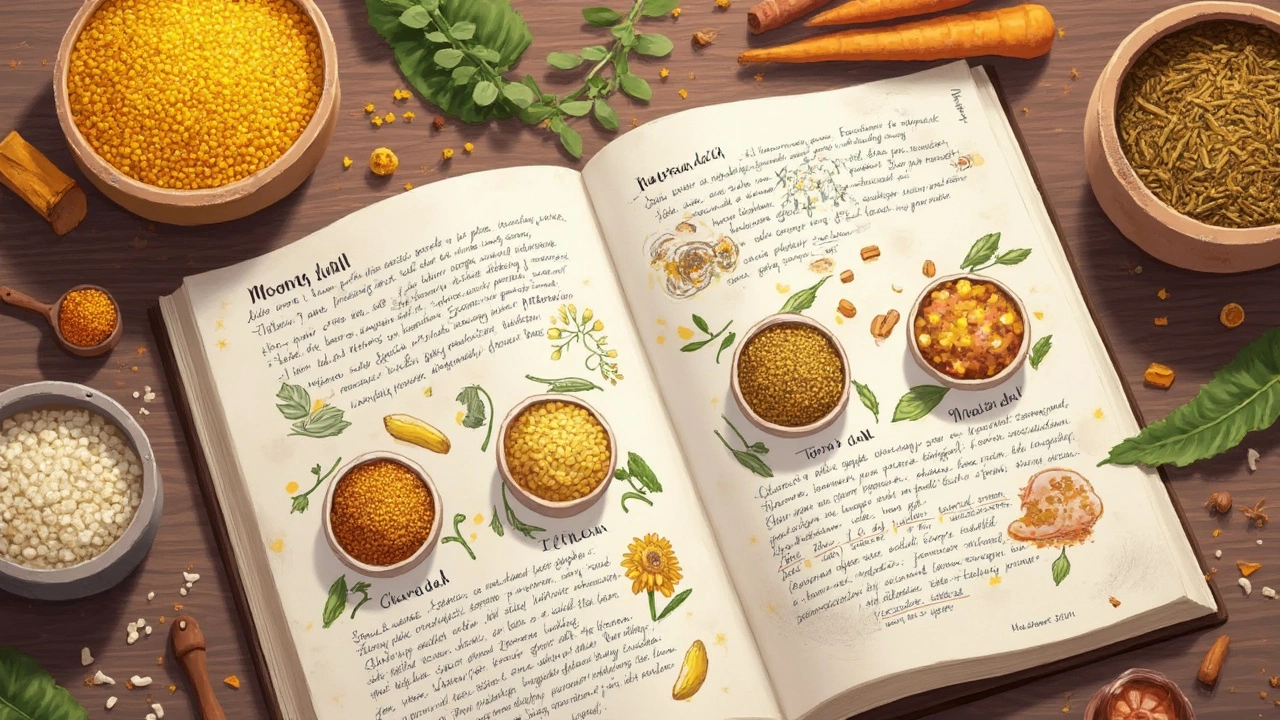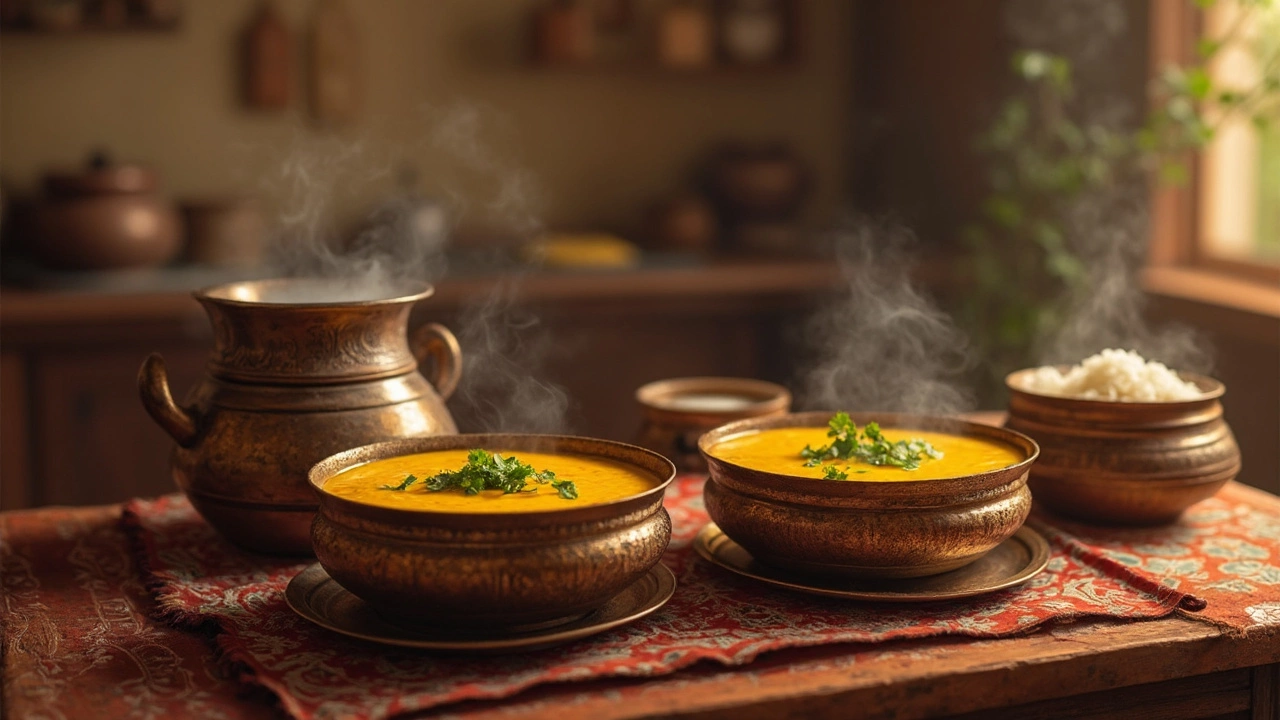So, you're wondering how much dal is just right for two people? It’s a common dilemma, especially when you want to avoid leftovers but also ensure everyone gets enough to eat. Typically, around 100 grams (or about half a cup) of raw dal per person is a good starting point. But wait, there's more than just plain math!
Dals come in many varieties, like split yellow moong, tour dal, or masoor. Each one absorbs water differently, meaning they expand differently when cooked. For two folks, a total of 200 grams should get you a hearty bowl each without leaving you swimming in dal for days.
Understanding Dal Types
Diving into the world of dal is like opening up a treasure chest of flavors and colors. Each type of dal has its own unique taste, texture, and cooking requirements. Whether you're cooking a dal recipe for a cozy dinner or an elaborate feast, knowing the different kinds can really up your game in the kitchen.
First up, tuvar dal (also called toor dal or split pigeon peas) is a staple in many households. It's medium gold in color and offers a slightly nutty flavor that pairs well with spices like cumin and mustard seeds. This dal is often used in sambhar and everyday curries across India.
Then there's moong dal, either split or whole. The split variety cooks quickly and has a mild taste, perfect for lighter stews. Meanwhile, whole moong need a bit more time and are often used in salads or sprouted dishes. Did you know whole green moong are one of the richest sources of plant-based protein?
Masoor dal or red lentils are another popular pick. They're quick to cook, making them a favorite for soups and lentil salads. The red hue disappears when cooked, leaving a creamy texture behind. According to Chef Anita Jaisinghani, "Red lentils are versatile and work brilliantly with both Western and Eastern flavors."
Red lentils are versatile and work brilliantly with both Western and Eastern flavors. — Chef Anita Jaisinghani
To give a clearer picture, here’s a comparison of how much water different dals absorb. This can help you gauge cooking times and textures:
| Dal Type | Water Absorption (per 100g) |
|---|---|
| Tuvar Dal | 2 cups |
| Moong Dal | 1.5 cups |
| Masoor Dal | 2.5 cups |
Knowing these differences helps you decide not just how much to cook, but also how to cook it. So next time you're at the grocery store, why not try a type you've never cooked before? It might just become your new favorite!
Perfect Portions for Two
Getting the perfect portions of dal for just two people can be tricky, but it's totally doable with a few practical tips. It's not just about grabbing a measuring cup and hoping for the best. You want to strike that sweet balance between having a satisfying meal and not wasting food.
Start by remembering that dal, in its uncooked form, tends to swell up quite a bit. You might begin with around 100 grams (3.5 ounces) of raw dal per person. While it might look like a modest amount, once it absorbs water and plumps up, it becomes quite a substantial meal.
Here’s how different types of dal typically expand when cooked:
- Split yellow moong dal: About 2.5 times its original size.
- Tour dal: Expands roughly 3 times.
- Masoor dal: Typically swells about 3 times.
Using these reference points, 200 grams of uncooked dal should yield enough for two sizable bowl servings, perfect if you’re pairing it with rice or bread.
Still hungry for more guidance? Keep in mind that ingredients you add—like tomatoes, spinach, or potatoes—can also beef up your dish, making it heartier.
Here's a quick tip: if you’re cooking dals with a thinner consistency (something we often crave when it's a cozy chill evening), you might want to adjust the quantities slightly or simply cook each type together. Blending dals can enhance flavors while making portion adjustments a breeze.

Cooking Tips
Getting the perfect dal comes down to a few simple but crucial steps. First, make sure you rinse your dal thoroughly. This removes dirt and extra starch, giving you a cleaner taste. Ideally, rinse until the water runs clear.
Next, let it soak. Depending on the dal type, soaking can range from 15 minutes (for moong or masoor dal) to a couple of hours (for chana dal). This speeds up cooking and ensures even softness.
When it's time to cook, use about three to four times the amount of water to dal. So, if you're working with 200 grams, that's around 600 to 800 ml of water. Here’s a trick: if you want creamier dal, stir it occasionally as it cooks. This breaks down some of the starches, giving it a richer texture.
Seasoning matters too! Instead of waiting till the end, add turmeric and salt during cooking. This enhances the flavor from the get-go. And don't forget a tadka or tempering of mustard seeds, cumin, garlic, and curry leaves in ghee or oil at the end for that traditional pop of flavor.
For those experimenting, using a pressure cooker or an Instant Pot can save time and energy, especially for tougher dals like chana or black gram. Just follow the manufacturer's instructions, and you'll have cooking dal down to an art.
Lastly, consistency is key. If the dal is too thick, just add a bit of water as it simmers. Too thin? Simmer it a little longer on low heat. Cooking the perfect dal is like an art, a mix of science, intuition, and a sprinkle of spice!
Creative Serving Ideas
Once you've got your dal cooked to perfection, don't just settle for the usual serving method. Let’s jazz it up so even a simple dish feels like dining out!
To start, you can transform your dal recipe into a comfort food fiesta by converting it into a soup. Add extra veggies like spinach or carrots for some crunch and nutrition. Throw in a dash of lemon juice before serving for that extra zing.
Fancy something hearty? Try making a dal khichdi. Mix your cooked dal with rice, add a little butter or ghee, and some spices like cumin and garam masala. It’s basically a warm hug in a bowl.
If you're feeling bold, go for dal-based pancakes or fritters. Mix the dal with flour, spices, and beaten eggs. Scoop the mixture onto a hot pan and cook until golden. Enjoy them with a tangy yogurt dip.
For those who love textures, try a simple dal chaat. Use crunchy sev, chopped onions, and tangy tamarind sauce to top your dal. It’s a party for your taste buds, trust me.
To make your meal visually appealing, present your dal servings with bright garnishes. Fresh cilantro, a swirl of cream, or a sprinkle of pomegranate seeds can add both color and flavor.
Here’s a quick look at how these serving ideas stack up in terms of traditional dal uses:
| Serving Idea | Flavor Profile | Typical Ingredients |
|---|---|---|
| Soup with Veggies | Light and Citrusy | Spinach, Carrots, Lemon |
| Dal Khichdi | Rich and Spicy | Rice, Cumin, Ghee |
| Pancakes/Fritters | Crunchy and Savory | Flour, Eggs, Spices |
| Dal Chaat | Tangy and Spicy | Sev, Tamarind, Onions |
No matter what you choose, remember the key is to make it your own. Don't hesitate to experiment. Sometimes the best dishes are the ones that were a happy accident!
